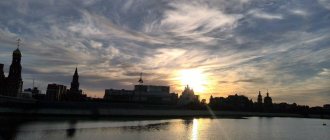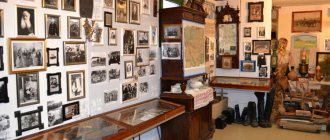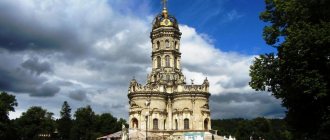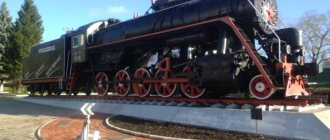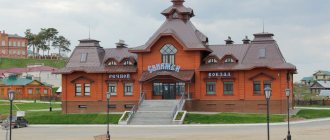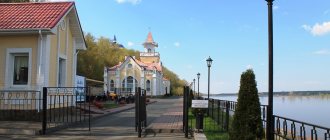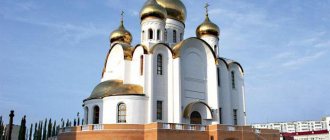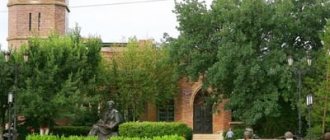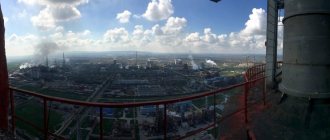There is a legend that Stepan Razin drowned a Persian princess in the Volga just near Kineshma, and this is what gave the city its name. Allegedly, the ataman brought the girl onto the deck, and she suspected something was wrong and asked: “Will you throw me?” But there is a more truthful version: the city got its name from the Finno-Ugric tribes that lived here before the arrival of the Slavs. Translated, it means “dark water.”
Kineshma is the birthplace of famous icon painters who worked on the decoration of the Moscow Kremlin: Pavel Nikitin, Andrei Makarov, Anton Amfilov, Gury Nikitin. Composers Sergei Rachmaninov and Alexander Borodin were inspired by local landscapes. For a long time, Alexander Ostrovsky served as a magistrate in the city, who used local legends when writing “The Snow Maiden”.
The area is famous for its anomalies: ghosts live in the local correctional colony and military unit. And in 2011, the builders of the sanatorium became eyewitnesses of strange phenomena: oak trees in the grove disappeared before their eyes, the earth swallowed stones, and people, as if under hypnosis, jumped from the scaffolding. This is due to the fact that there was a pagan sanctuary here for a long time.
Islands and lakes, ostriches, museums, monasteries - what not to miss when driving through the Ivanovo region.
How to get to Kineshma from Moscow
By car
Of course, the most convenient way to get there is by car. The drive from Moscow to Kineshma is about 400 km if you choose the route along the M-7 highway through Vladimir and Suzdal. By the way, it turns out to be an excellent road trip to the cities of the Golden Ring - suitable for both short vacations and long holidays (for example, New Year holidays). But let's get back to the main route. The disadvantages of the M-7 route include the advantages listed above. If you do not plan to stop in Suzdal or Vladimir, then you will most likely still be delayed on the road, but due to traffic jams and congestion. Therefore, the route along the Yaroslavl highway (M-8) may be even faster, although 60 km longer. In this case, you need to turn right at Pereslavl-Zalessky onto P74 towards Yuryev-Polsky. You can also stop here to explore the Kremlin; a couple of hours is enough for a city tour.
By public transport
If you travel by public transport, there are two options:
By train 662E
Travel time is 10 hours 20 minutes, departure from Moscow at 22:05 daily. Schedule of ticket prices and route. It’s convenient – I got on the train in the evening, got some sleep, and went straight to the excursion in the morning.
By bus
Travel time is 7 hours or 7 hours 30 minutes. There are two buses every day: at 9:30 and at 12:30. Schedule and prices for bus tickets to Kineshma. Departure from Moscow from Shchelkovsky or Novogireevo bus stations.
Conclusion: the train is a little more expensive (if you take a reserved seat or a compartment), but much more convenient.
Waterbus prices
The cost of a boat trip Kineshma - Ples - Kineshma by boat is 800 rubles, a one-way ticket will cost 480 rubles. You can get to Reshma by suburban tram for 340 rubles, with a return ticket for 600 rubles. A single ticket from Kineshma via Zhazhlevo to Reshma costs 660 rubles. Children from 5 to 14 years old, as well as pensioners, war and labor veterans enjoy the right to discounted travel (half the ticket price). Children under 5 years old, accompanied by an adult, can ride the river bus for free.
Along with regular passenger flights from Kineshma to Plyos, there is a cruise of the M-235 motor ship of the Mirnaya Prystan hotel complex. Tourists are offered various leisure formats:
- an hour's walk along the Volga expanses;
- weekend tour by water bus;
- romantic getaway for two.
It is possible to rent a water bus (with a capacity of 60 people) to celebrate various events:
- graduation of schoolchildren, students;
- birthday, anniversary;
- corporate event;
- weddings, on-site marriage registration.
There are also private boats that moor at the pier behind the river station. Prices for walks start from 300 rubles. and depend on the duration of the cruise.
Where to stay in Kineshma
First, I’ll tell you where we stopped this time, it’s worth it. The hotel found on the booking site is not just located on the Volga embankment, it literally stands on it. This time we stayed in a boat (no typo). For those who have not yet heard this newfangled word, I’ll tell you. In fact, it is a composite of two English words: boat, (boat, ship, vessel) + hotel.
It turned out to be a boat - a hotel on the water, a former ship rebuilt as a hotel, that is, devoid of ship mechanisms. The boat in Kineshma is called “Peaceful Marina”. The beauty of this particular hotel is not that it is located on the water, although this fact in itself does not play a role; you can’t sail far on this boat.
Another thing is important - you live in the very center of the city and at the same time, as a bonus, you get the opportunity to walk along the embankment and directly from the window or from the deck admire the sunset over the Volga, the sunrise over the Volga, the Volga itself, in general, enjoy the surrounding landscape without any obstacles.
Volzhsky Boulevard Day
Every year in September, Volzhsky Boulevard Day is celebrated in Kineshma, and it is celebrated on a grand scale. On this important day for the city, festive events are held on the embankment.
Below you can see a photo of a huge samovar on the embankment, which on holidays turns into a stall with hot pies and aromatic coffee. Volzhsky Boulevard becomes a festive place where people of all ages enjoy relaxing, because the grandiose holiday unites several generations.
Samovar on Volzhsky Boulevard
People buy souvenirs, listen to performances by musical groups, and participate in various competitions. And in the evening of this day there is a stunning fireworks display over the Volga - a colorful and unforgettable sight!
History of Kineshma
As usual, I will give a short excursion into the history of the city. The first written mention of Kineshma dates back to 1504, when “The Grand Duke of Moscow and the Great Sovereign of White Rus' by God’s Grace” Ivan III came to Kineshma as the inheritance of Prince F.I. Velsky on the occasion of the latter’s marriage to the royal niece Princess of Ryazan. In the late Middle Ages, Kineshma was a fortress, one of the outposts of Russia on the Volga. Rising from the north over the steep bank of the river, the fortress was surrounded by ditches and ramparts, and fortified along the entire perimeter with log walls.
At the beginning of the 17th century, during the period of the Polish-Lithuanian intervention, the citizens and villagers of Kineshma fought desperately with the troops of Pan Lisovsky, but the forces were unequal, and the fortress fell. Later, chapels were erected at the battle sites in memory of the fallen Kinesha residents.
By 1616, Kineshma became the center of the Kineshma district, which included Kineshma, Vichugskaya, Merinovskaya and Vladychenskaya volosts. The city, thanks to its favorable geographical location, conducts extensive trade with other cities of the Volga region, north-west Russia and Moscow. It was inhabited at that time mainly by traders and artisans.
In 1708, Kineshma became part of the Arkhangelsk province, and since 1719 it became part of the Yaroslavl province. In 1777, during the administrative reform, Kineshma was assigned to the Kostroma governorate and became a district town of the Kostroma province. In the second half of the 18th century, crafts actively developed in Kineshma: icon painting, tailoring, blacksmithing, shoemaking, mitten making, as well as the manufacture of wooden utensils, tubs, ladles, shovels and bast shoes. By the end of the 18th century, Kineshma canvases and canvases were sold at local fairs and exported in large quantities to St. Petersburg and Moscow.
With the beginning of the Patriotic War of 1812, the residents of Kineshma formed the Kineshma militia, led by Lieutenant General Bardakov, which became part of Kutuzov’s army.
Kineshma, 1913
In 1871, a railway was built in Kineshma, connecting the city with Moscow. At that time, Kineshma became an industrialized center.
Sights of Kineshma
Today in Kineshma there is little reminiscent of those “golden” times; the city is a typical province for central Russia in the good sense of the word. If the navigator led you to the very center, then, like in any other city in Russia, it will be waiting... In any weather, day or night, this silhouette invariably tells us: here is the city center, here is the street named after me, and here is Sovetskaya.
In fact, the city leaves a very pleasant impression. Yes, there are a lot of dilapidated buildings, yes - the roads are not so hot (and where are they good in our country?). Nevertheless, it’s nice to walk around Kineshma, the embankment is especially nice. The city is quiet and calm, even on the central streets. This is not Plyos or Suzdal, overrun by tourists, this untouched province still remains here.
Volzhsky Boulevard
One of the most beautiful places in Kineshma, loved by both tourists and locals. According to the tradition of the Volga embankments, the boulevard ends with a gazebo.
It is interesting that this tradition has been going on for a long time. You can find a gazebo on the embankment, for example, in photographs of the city taken in 1914.
Trinity-Assumption Cathedral
The boulevard turns into a park, which abuts the ensemble of the Trinity-Assumption Cathedral, consisting of two churches (Trinity 1838, Assumption 1745) and a bell tower, built somewhat later - in 1798. The cathedral is beautiful, but, as always happens with us, the view is spoiled by wires, although no electric transport was noticed in Kineshma.
The Assumption Cathedral remained active for almost the entire Soviet period, preserving ancient church utensils and icons. The main churches that make up the ensemble of the Assumption-Trinity Cathedral are architectural monuments of the 18th-19th centuries. In 1834, Sovereign Emperor Nicholas I visited the Assumption Cathedral. There is an inscription on a column in the cathedral about this important event in the life of the cathedral.
“This holy temple, in 1834, on the 9th day of October, was visited by His Imperial Majesty, Sovereign Emperor Nikolai Pavlovich.”
The construction of Trinity Cathedral was completed in 1838. Built in the spirit of classicism, according to the design of the architect I.E. Efimov, the cathedral became an excellent addition to the temple ensemble. Trinity Cathedral is a century younger than the Assumption Cathedral, and the airiness of its paintings is emphasized by the multi-window dome, thanks to which the entire cathedral seems to be flooded with light.
Since 1866, in connection with the establishment of the Kineshma Vicariate, these cathedrals became cathedrals. On patronal feast days, the bishop serves under their arches.
Next to the cathedrals rises a bell tower - one of the most interesting bell towers in the Ivanovo region, built in a style transitional from Baroque to Classicism. The slender four-tiered structure consists of quadrangles gradually decreasing in plan and is completed with a faceted domed roof with lucarnes, above which two more quadrangles rise, crowned with a vase-shaped dome and a high spire directed into the sky.
The view of the bell tower as a whole on Kineshma is much more interesting from the left bank of the Volga and is a bit reminiscent of the view of the Peter and Paul Fortress in St. Petersburg.
Ensemble of Ascension Churches
Another very interesting attraction is the ensemble of Ascension churches, consisting of the Temple of the Ascension of the Lord and the Chrysostom Church.
This ensemble was erected in the second half of the 18th century on the site of the Widow's Monastery, founded in honor of the events of 1609 (the struggle of the Kineshem people against the Polish-Lithuanian intervention). The Church of St. John Chrysostom is an original monument, combining the forms of pre-Petrine architecture and the Baroque style of the 18th century. The Church of the Ascension is a monumental building with a rare appearance for the last quarter of the 18th century. commitment to ancient Russian forms in their laconic interpretation.
Architecture of Kineshma
Apart from churches and cathedrals, there are no famous attractions in the city. However, the central part of the city attracts with low-rise buildings of the 19th century. There are practically no new buildings here, with the exception of the above-mentioned Ilyich and the Drama Theater named after A.M. Ostrovsky.
Thus ended our trip to Kineshma. In three days we managed to see Suzdal, Plyos and Kineshma, and if not for the rainy weather, we would have seen much more.
Share link:
- Click to share on Twitter (Opens in new window)
- Click here to share content on Facebook. (Opens in a new window)
Article updated:16/01/19
Where does the tram depart from?
The Kineshma river station opened in 1975. Three years later, the pier began operating, accepting dozens of different vessels: cargo, pleasure, high-speed. The quay wall was divided into passenger and cargo parts. Like many other cities, the river station did not survive the crisis of the 90s; now its building houses a shopping center. Until 2004, tours along the Volga by boat from Kineshma were organized according to a fixed schedule. But then all the ships were sold or written off, and only river buses remained in the city. Nevertheless, the port receives ships from Moscow, St. Petersburg, and from neighboring regional centers - Ivanovo, Vladimir, and other cities.
River trams operate regularly, departing from the passenger pier at pl. Revolutions, 9. The second boarding point for pleasure fleet cruises is located at the Kuznetsky Bridge, the third is the afloat hotel “Mirnaya Pristan”.
Along the route Plyos - Kineshma, the ship returns tourists to the point of departure.
The town of Kineshma has retained the flavor of the 19th century in its historical part. Local merchants and industrialists of that era not only built personal mansions, but also donated considerable sums for the construction of temples. Thanks to this, the “texture” of the streets attracts filmmakers: the films “Dowry”, “Vassa”, “Mistress of the Taiga”, “Chinese Service” were filmed here.
Guests of the city can also visit the unique Felt Felt Museum, stroll along Volzhsky Boulevard, and see numerous ancient churches of Kineshma.
